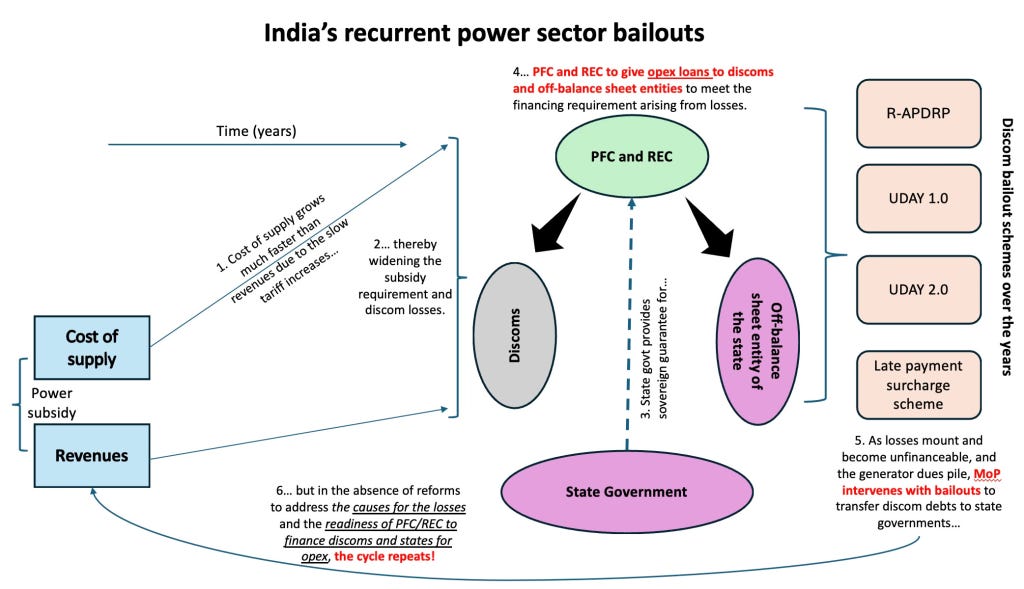O What A Tangled Web We Weave
In Gulzar Natarajan's recent blog post, he shares an insightful diagram that illustrates the complexities of India's power sector bailouts.
The diagram itself is intricate, with various entities and relationships woven together in a repeating cycle. There is certainly nothing to disagree with in the portrayal—it's a well-drawn map of the state of affairs. But for me, as an economist, there's another way to look at this story. A way that can cut through the layers of actors, acronyms, and interventions to uncover the core issue: the simple economics of price, cost, and choice.
You see, the whole tangle of India's recurring power sector bailouts comes down to a choice that is made early on, but has far-reaching consequences. The problem begins with a straightforward discrepancy: the cost of supplying power grows much faster than the revenues coming in because tariffs don’t keep pace with rising costs. It’s really that simple—that's steps 1 and 2 in the diagram. The cost of producing electricity increases, but the price that consumers are charged (tariffs) doesn’t rise to match it.
The result? Discoms (distribution companies) start incurring losses. As these losses widen, a decision point emerges: do we address the underlying problem by allowing tariffs to rise? Or do we find creative ways to hide or defer the problem? Unfortunately, the latter choice has been our default approach, as shown by steps 3, 4, 5, and 6 in the diagram.
If you've ever watched the TV show Friends, you might remember Monica’s secret closet—the one place in her otherwise perfectly tidy apartment where all the clutter is hidden away. That’s exactly what our approach to power sector reform has looked like. We’ve become adept at creating financial closets to stash away the growing mess. Whether it’s through state guarantees, new financing entities, or another round of bailout schemes, each step represents another mechanism to keep the issue out of sight without actually fixing it.
But here's the truth: we can't keep hiding the problem forever. Ultimately, the only sustainable solution is to allow prices to reflect costs. Tariffs need to rise, and cross-subsidization—where one group of consumers pays more to make up for another group paying less—needs to end. Until we face this reality, every other solution is just a temporary patch. We can rename schemes, introduce new policy initiatives, and continue devising creative financial instruments, but unless the end consumer pays a price that aligns with the actual cost of supplying electricity, nothing else will fundamentally work.
Economics is often seen as complicated, but it can also be refreshingly straightforward. This is one of those cases: costs must be covered by revenues.
It really is that simple.
If you've read this far, thanks! This entire essay was almost entirely written by ChatGPT, in Canvas mode.
This was the prompt that I gave it (all the typos were there in my prompt, I didn't bother correcting anything, and I pasted in the image separately as well):
Gulzar Natarajan posted a blogpost recently (https://gulzar05.blogspot.com/2024/12/indias-power-sector-problems-in-graphic.html) in which he shared this picture. I want to write a short blogpost that highlights how principles of economics is an underrated subject, because it can make a complicated story relatively simple.
There is nothing to disagree with, per se, in this diagram. But I would tell the story differently. I would highlight how one choice creates the problem, and how another choice exacerbates the problem. THe problem is created when tariffs don't rise in line with the changing costs of supply. That is, 1. and 2. in the diagram is really the entire problem. Now, once you create the problem, you have to come up with either a solution, or an effective mechanism to hide the problem (and the analogy that comes to mind is Monica's secret closet where she hides all of her crap in the television series Friends). 3., 4., 5. and 6. are all mechanisms to brush the problem under the carpet, and unfortunately we've gotten really good at this latter bit. But the solution, ultimately, has to lie in allowing prices to incrrease. YOu can dance around the numbers, the policy names and the new (not to mention the "new new") initiatives as much as you want, but when it comes to supplying electricity in a financially sustainable way in this country, there really is only one thing to do: raise the price that the end consumer pays, and end cross-subsidization. Until that happens, nothing else will work. It just is that simple.
Write up a persuasive blog post draft including these points, I would like to edit it with you
I made some minor changes here and there, but I was more than satisfied with the draft. I personally do not think it is "my style", but:
Opportunity costs are everywhere. What takes me about an hour took about twenty minutes. Is forty minutes worth preserving my "style" if I'm able to make the point I wanted to make?
If the point is being made without all the rhetorical flourishes I ight have added, is there an argument to be made for this version actually being better for you, the reader?
I'm all about laziness. If you want to make me feel better, you can rephrase that to "I'm all about minimizing effort". But if I'm able to put up a blogpost that is good enough, and that with minimal effort, sign me up! Or that, at any rate, is my current thinking.
I will always make clear which posts have been written by me alone, and which ones have been written with the help of ChatGPT or other LLM's (Canvas mode or otherwise). But going forward, I will be experimenting with writing more and more by using Canvas mode. Look for the tag "written with chatgpt".
Consider yourself warned! :)


